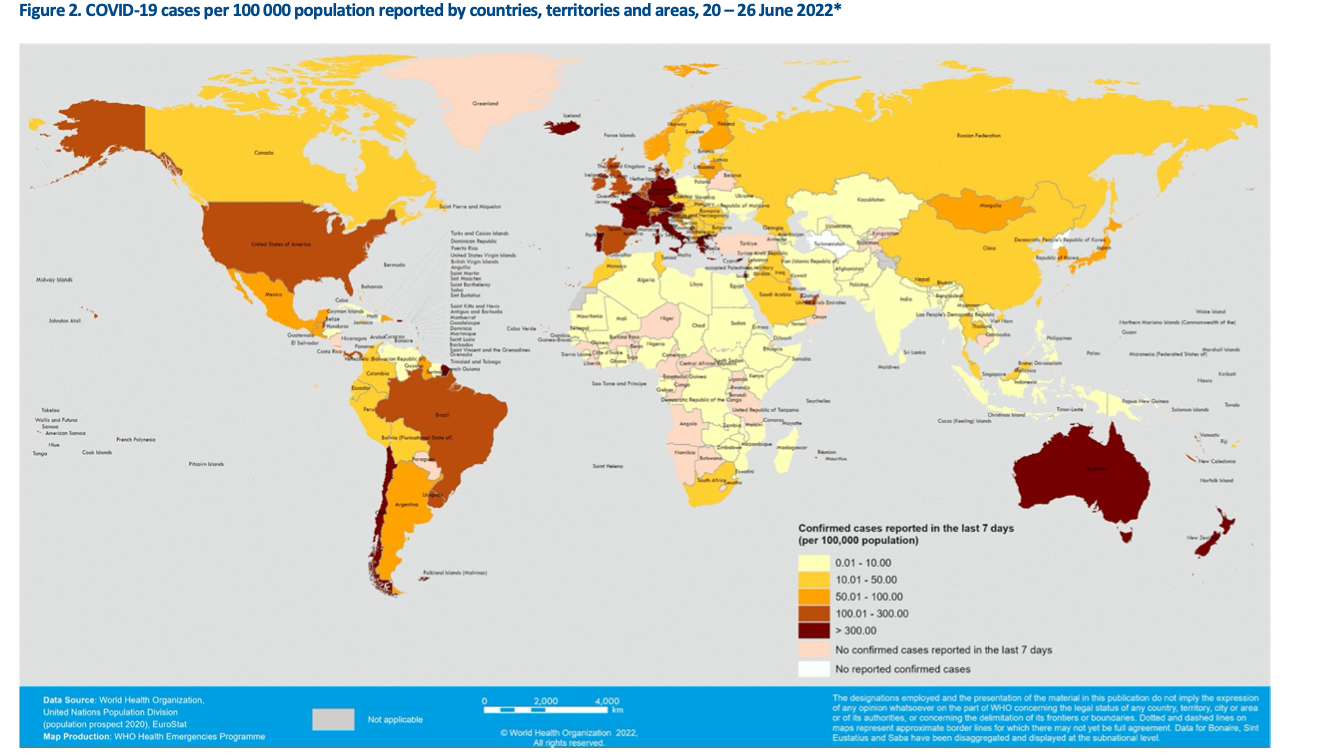Global overview Data as of 26 June 2022
Globally, the number of weekly cases has increased for the third consecutive week, after a declining trend since the last peak in March 2022. During the week of 20 to 26 June 2022, over 4.1 million new cases were reported, an 18% increase as compared to the previous week (Figure 1). The number of new weekly deaths remained similar to that of the previous week, with over 8500 fatalities reported.
At the regional level, the number of new weekly cases increased in the Eastern Mediterranean Region (+47%), the European Region (+33%), the South-East Asia Region (+32%), and the Region of the Americas (+14%), while it decreased in the African Region (-39%) and the Western Pacific Region (-3%). The number of new weekly deaths increased in the Eastern Mediterranean Region (+22%), the South-East Asia Region (+15%), and the Region of the Americas (+11%), while decreases were observed in the Western Pacific Region (-6%), the European Region (-5%) and the African Region (-1%).
As of 26 June 2022, over 541 million confirmed cases and over 6.3 million deaths have been reported globally.
These trends should be interpreted with caution as several countries have been progressively changing COVID-19 testing strategies, resulting in lower overall numbers of tests performed and consequently lower numbers of cases detected.

At the country level, the highest numbers of new weekly cases were reported from the United States of America (701 855 new cases; +5%), Germany (504 655 new cases; +23%), Brazil (349 791 new cases; +37%), Italy (340 012 new cases; +61%), and China (333 926 new cases; -18%).
The highest numbers of new weekly deaths were reported from the United States of America (1997 new deaths; -2%), Brazil (1313 new deaths; +37%), China (925 new deaths; -11%), the Russian Federation (429 new deaths; -3%), and Italy (355 new deaths; +5%).


Special Focus: Update on SARS-CoV-2 variants of interest and variants of concern
WHO, in collaboration with national authorities, institutions and researchers, routinely assesses if variants of SARS-CoV-2 alter transmission or disease characteristics, or impact the effectiveness of vaccines, therapeutics, diagnostics or public health and social measures (PHSM) applied to control disease spread. Potential variants of concern (VOCs), variants of interest (VOIs) or variants under monitoring (VUMs) are regularly assessed based on the risk posed to global public health.
The classifications of variants will be revised as needed to reflect the continuous evolution of circulating variants and their changing epidemiology. Criteria for variant classification, and the lists of currently circulating and previously circulating VOCs, VOIs and VUMs, are available on the WHO Tracking SARS-CoV-2 variants website. National authorities may choose to designate other variants and are strongly encouraged to investigate and report newly emerging variants and their impact.
Geographic spread and prevalence of VOCs
There continues to be a decline in the number of SARS-CoV-2 sequences submitted to GISAID, as compared to January 2022 when 1 248 906 sequences were submitted. From 27 May to 27 June 2022, 146 183 SARS-CoV-2 sequences were submitted to GISAID. Among these sequences, the Omicron VOC remains the dominant variant circulating globally, accounting for 94% of sequences reported in the past 30 days. Among Omicron sequences, as of epidemiological week 24 (13 to 19 June 2022) BA.2 represents 25%, while BA.2.12.1 represents 11%, BA.4 represents 12%, and BA.5 represents 43%. Comparing the proportion of Omicron sequences submitted during epidemiological weeks 23 (6 to 12 June) and 24, BA.2 declined from 30% to 25%, BA.2.12.1 declined from 18% to 11%, while BA.4 increased from 9% to 12% and BA.5 increased from 28% to 43%.
These trends should be interpreted with due consideration of the limitations of surveillance systems, including differences in sequencing capacity and sampling strategies between countries, as well as changes in sampling and sequencing strategies in multiple countries.











